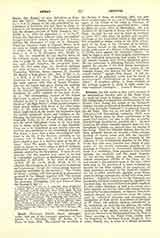

Annates, the first fruits, or first year’s revenue of an ecclesiastical benefice paid to the Papal Curia (in medieval times to bishops also). One result of the centralizing of ecclesiastical administration in the Roman Curia during the course of the thirteenth century was that ecclesiastical benefices became more and more generally “collated,” i.e. granted, directly by the Pope. This was so, not only in the case of bishoprics and monasteries, vacancies which were filled by Rome either by direct appointment or by papal confirmation, but also in the case of smaller church livings (canonicates, parishes, etc.). On such occasions the papal treasury received from the new incumbent a certain tax derived from the income of the living. Since the fifteenth century this tax has been generally known as annates, a term comprehending all money taxes paid into the Apostolic Camera (papal treasury) on the occasion of the collation of any ecclesiastical benefice by the Pope. Under this term were included four classes of payments: (I) the servitia communia, payable on the granting of bishoprics or monasteries, appointments made in a consistory; these payments were divided between the cardinals and the papal treasury; (2) the servitia minuta, due on like occasions to various subordinate officials of the Curia; (3) the real annatee in the narrower sense of the term, which were paid on the granting of a minor ecclesiastical benefice by the Pope outside of the consistory; all these payments reverted to the Apostolic Camera; (4) the so-called quindsocalledennia, payable every fifteen years by livings permanently united with some other benefice. Originally, however, in the thirteenth and fourteenth centuries, annatae, or annalia, signified only the third class, the taxes derived from lesser benefices. In their origin, therefore, as well as in actual character, annates are distinct from other money tributes received by the papal treasury, or Camera, from ecclesiastical persons and institutions—from the census paid by individual churches and monasteries in recognition of their direct dependence on the Chair of St. Peter, the pallium moneys contributed by an archbishop on receiving the pallium, the visitation tributes given by an individual bishop and archbishop on his regular visitatio ad limina. Still more are annates to be distinguished from the Peter’s-Pence accruing to the Papal Curia chiefly from the kingdoms of Northern Europe (England, Denmark, Poland, etc.) in token of a certain protection accorded by the Roman Church, and from the feudal tribute due from such territories as stood in real feudal relationship to Rome (e.g. Naples). Among the payments made to the Roman Curia in the fifteenth century under the general term of annates, the oldest are the servitia communia and the servitia minuta. At a very early period bishops who received episcopal consecration in Rome were wont to present gifts to the various ecclesiastical authorities concerned. Out of this custom there grew up a prescriptive right to such gifts; in the first half of the thirteenth century a regular scale of payment was prescribed for all the dioceses and abbeys liable to this tax upon appointment or confirmation of their prelates. During the thirteenth century there likewise arose in many cathedrals and collegiate churches the custom of appropriating for the bishops or other ecclesiastical officials a year’s income from vacant benefices. In exceptional cases some bishops received from the Pope authority to levy this annate on all benefices in their dioceses falling vacant within a specified period. In 1306 Clement V reserved for the papal treasury a year’s revenues from all benefices throughout England and Scotland at that time vacant or falling vacant within a period of three years. John XXII, in 1316, made a similar reservation of annates for three years on all ecclesiastical livings, with a few exceptions. From this time on the popes of the fourteenth century were very frequently forced to adopt these measures to obtain relief in financial straits. Moreover, after the thirteenth century the annate was required from benefices that had been for any reason whatever collated directly by the Pope. This tribute was fixed by John XXII (1316-34) at half the annual revenue. At the Council of Constance (1414-18) and later, many complaints were made concerning these assessments; and in concordats made by the popes with separate countries the annates were regulated anew. In particular it was decided that annates on reserved benefices could be paid to the Curia only when the annual income exceeded twenty-four gold gulden. With the gradual transformation of the system of benefices, the annates, strictly so called, disappeared. Today they are levied only on the occasion of new appointments to dioceses not subject to Propaganda, and after the manner fixed by the latest concordats or by the papal documents (Bulls of Circumscription) that le ally establish a diocese.
J. P. KIRSCH

